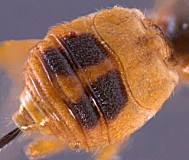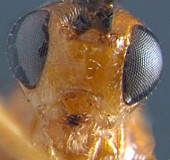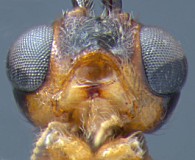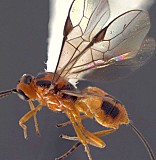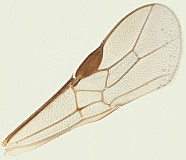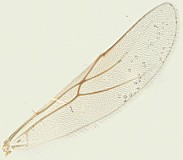Bracon Fabricius
Remarks
The genus Bracon is one of the largest in the family Braconidae, with over 2000 described species. Two species, Bracon celer Szépligeti from Subsaharan Africa and Bracon fletcheri Silvestri from India have been reared from tephritid pests as part of biological control programs directed against species in the genus Bactrocera.
Description
Members of the genus Bracon, though superficially resembling some of the Opiinae, can be distinguished by the venation of the hind wing, in which the subbasal cell (Fig. 6, lower left corner) is distinctly smaller than it is in the Opiinae. All species of Bracon lack the occipital carina, whereas many of the Opiinae have the occipital carina present laterally. The labrum is exposed and distinctly concave in Bracon (Fig. 3) relative to members of the Opiinae, but this difference may not always be apparent until some familiarity with the variation in Opiinae is acquired.
Distribution
No referenced distribution records have been added to the database for this OTU.
Biology / Hosts
Members of the genus Bracon are amongst the most commonly encountered parasitoids emerging from infested fruits in certain parts of the world (e. g. Subsaharan Africa). Most of these species are undoubtedly parasitoids of lepidopteran and coleopteran hosts, but specific host associations have rarely been made. Other genera of the Subfamily Braconinae have also been routinely reared from fruit, but host associations for most of these are also rarely reported. It is quite possible that some of the species in these other genera may attack fruit-infesting Tephritidae.
Biology and Behavior
The species of Bracon that attack frugivorous tephritids are idiobiont ectoparasitoids of larvae. The female wasp paralyzes the host and the larva develops on it inside the fruit, eventually spinning a cocoon and emerging as adult wasps from the fruit. Sampling programs that rely on emergence of host larvae from fruit and subsequent isolation of puparia for emergence of flies and parasitoids will either underestimate or completely miss these parasitoids.
Biological Control
Bracon celer is a parasitoid of olive fly, Bactrocera oleae (Rossi) and efforts have been made to introduce it from Africa (where it is native) to several countries in the Mediterranean Region. As noted by Silvestri, who first reared it in South Africa, it is a color-variable species.

